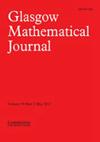矩阵在pid上与理想类对应的相似类的表示
IF 0.4
4区 数学
Q3 MATHEMATICS
引用次数: 0
摘要
摘要对于一个主理想域$ a $,利用Latimer-MacDuffee对应建立了$\textrm{M}_{n}(a)$中具有不可约特征多项式$f(x)$的矩阵的相似类与阶为$ a [x]/(f(x))$的理想类之间的双射。我们证明了当$A[x]/(f(x))$是极大的(即积分闭域,即Dedekind定义域),那么每一个相似类都包含一个代表,在某种意义上,它接近于一个伴矩阵。证明的第一步是证明任何与一阶理想(不一定是素数)相对应的相似类都包含一个期望形式的代表。第二步是先前未发表的Lenstra结果,该结果表明,当$ a [x]/(f(x))$是最大值时,每个理想类都包含一个1度的理想。本文章由计算机程序翻译,如有差异,请以英文原文为准。
Representatives of similarity classes of matrices over PIDs corresponding to ideal classes
Abstract For a principal ideal domain $A$ , the Latimer–MacDuffee correspondence sets up a bijection between the similarity classes of matrices in $\textrm{M}_{n}(A)$ with irreducible characteristic polynomial $f(x)$ and the ideal classes of the order $A[x]/(f(x))$ . We prove that when $A[x]/(f(x))$ is maximal (i.e. integrally closed, i.e. a Dedekind domain), then every similarity class contains a representative that is, in a sense, close to being a companion matrix. The first step in the proof is to show that any similarity class corresponding to an ideal (not necessarily prime) of degree one contains a representative of the desired form. The second step is a previously unpublished result due to Lenstra that implies that when $A[x]/(f(x))$ is maximal, every ideal class contains an ideal of degree one.
求助全文
通过发布文献求助,成功后即可免费获取论文全文。
去求助
来源期刊
CiteScore
1.10
自引率
0.00%
发文量
36
审稿时长
6-12 weeks
期刊介绍:
Glasgow Mathematical Journal publishes original research papers in any branch of pure and applied mathematics. An international journal, its policy is to feature a wide variety of research areas, which in recent issues have included ring theory, group theory, functional analysis, combinatorics, differential equations, differential geometry, number theory, algebraic topology, and the application of such methods in applied mathematics.
The journal has a web-based submission system for articles. For details of how to to upload your paper see GMJ - Online Submission Guidelines or go directly to the submission site.

 求助内容:
求助内容: 应助结果提醒方式:
应助结果提醒方式:


